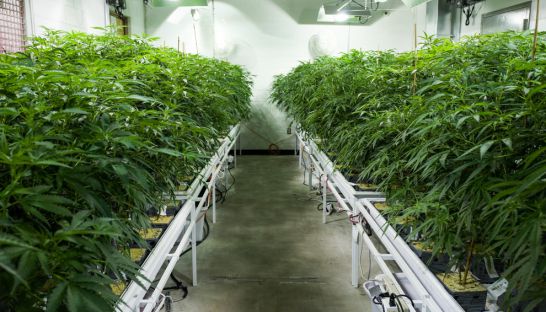Prospect for a budding industry
Prospect for a budding industry
With Cambodia’s traditional cash crops struggling to compete in global supply chains, the Kingdom could carve out a lucrative niche in commercial cannabis harvesting and exports – provided it acts fast to take advantage of the falling legal barriers, a Cambodia-based American innovator has argued.

Jim Plamondon, a former technical evangelist for Microsoft, said cannabis, the flowering plant that produces marijuana, was a potential goldmine for the Kingdom’s agricultural sector, which employs two-thirds of the country’s workforce.
He said US elections earlier this month were a tipping point, with more than half of the 50 US states having now legalised marijuana for medical use, such as treatment of glaucoma, and seven states legalising it for recreational use.
Cannabis legislation by the US federal government is now widely seen as inevitable, he said, which would remove the main barrier to international legislation and trade. And if the US allows marijuana imports, first movers in the market stand to reap billions.
“The key point is that after the November elections in the US, [full legalisation] is inevitable,” Plamondon said yesterday, adding that if the Kingdom acted now, it could build a world-class cannabis supply chain for export in about five years.
While on paper, Cambodian law still classifies marijuana cultivation as illegal, the government has historically allowed small-scale farmers to grow the plant for personal consumption.
Even if Cambodians fail to see the economic potential of legalising cannabis, other countries certainly will, Plamondon said.
China, where cannabis is still illegal, has already registered 600 cannabis-related patents with the World Intellectual Property Office (WIPO) in preparation of a booming global trade.
Plamondon believes that unless China lifts its ban on cannabis, Chinese firms will clamour to find an offshore country willing to allow them to conduct research and development on cannabis and its products.
“These firms desperately need to do research and development and market-testing environment in which their cannabis-related activities are legal,” he said. “Same with the big global tobacco companies that are moving into cannabis.”
While he does not expect that the Beijing government would support Cambodia’s legalisation of marijuana publically, “behind the scenes, however, legalisation in Cambodia gives Chinese firms an optimal path to profitable commercialisation in the West”.
This would result in a flood of foreign direct investment over the next two to seven years, he predicted.“Declaring cannabis to be legal in Cambodia requires no investment by Cambodia. The investment is made by foreign direct investors,” he said. “There’s nothing but upside for Cambodia. It’s a net gain from day one.”
A report earlier this year issued by US-based New Frontier and ArcView Market Research predicted that the US cannabis market would reach $7.1 billion in 2016 driven by recreational sales. Forbes described it in 2015 as the “best start-up opportunity” as the US began liberalising its drug policies.
John Muir, a consultant for Cambodian rice exporter Soma Group and an Australian “hemp” economist, said that its commercial cultivation would also help to diversify crops.
“Cambodia and the region have been far too dependent on monoculture rice farming,” he said. “The best practice is to diversify crops and the cannabis market has a huge potential as it can be planted year-round.”
Canada, which legalised cannabis-derived hemp in 1998, is one country already benefitting from falling US legal barriers.
According to Muir, the hemp industry, which is used from everything from manufacturing rope to clothing and vegan food ingredients, was a $10 billion industry for Canadian exporters to the US over the last decade.
“Now with laws in the US changing, the market is unlimited,” he added. Whereas Cambodia had little control over the falling prices for traditional agricultural crops, if properly spearheaded the Kingdom could jump ahead of global competition. But the window is closing.
Muir noted that countries like Uruguay, which has slowly rolled out a state-owned cannabis initiative effective this month, was poised to tap into the US market. “It is not just about marijuana, it is about creating a vibrant hemp industry that increases farmer’s outputs and margins,” he said.
A long-time European agricultural expert working for an international developmental agency in Cambodia, who declined to be named, welcomed the prospect of cannabis farming.
“When you look at what is going on in the Cambodian rice industry, it doesn’t do very well because of bad supply chains,” the source said.
Noting that highland areas of the Cardamom Mountains and the provinces of Mondulkiri and Ratanakkiri were ideal for cannabis farming, the source said if Cambodia ever adopted industrial-scale harvesting, it would need to invest in large-scale export capabilities, processing standards and ideally form an industry body to focus on competition.
Khan Samban, director of the industrial crops department at the Ministry of Agriculture, said that while cannabis was still illegal, with proper motivation the government could consider lifting the ban.
“It is an easy crop for planting and can grow in many areas,” he said. “If it gives us a big potential market in a new industry, and if countries like the US or the European Union negotiate deals with Cambodia, I think the government would consider amending the law for special cases.”
Even if the US legalises marijuana imports, the lack of direct shipping routes from Cambodia could mean deliveries would have to pass through countries that currently prohibit its trade or transport. Plamondon, however, played down the concern.
“Because a single container of legal cannabis would be worth tens of millions of dollars, direct-to-US air cargo would be entirely cost-effective, bypassing all such obstacles,” he said.













